- 15 days of bliss in Spiti Valley and Kinnaur including Sangla and Chandratal Lake. Neeraj shares a day by day account with lovely pictures. The majestic mountains, river meeting points, the everchanging terrain, daring drives on non- existent roads, sparkling blue lakes, hikes at high altitude and many centuries old monasteries created memories that can last a lifetime. But as they say, there is a greater joy in sharing - so here it is.
When we think of nature, peace and tranquillity, we head to the mountains! The region of Sangla and Spiti in Himachal Pradesh offers even more than that – the simplicity of people, immense faith, happy faces and abundance of natural beauty. The majestic mountains, multiple rivers and their meeting points, winding and often difficult terrain, sparkling blue lakes, hikes through the forests, delicately preserved centuries old monasteries and lack of continuous digital connectivity allows you to spend real quality time with just yourself!
We
planned a 15-day trip to this region in end August of 2022. While the pen
cannot do justice to what we experienced, I have captured day-wise highlights
with insights and pictures.
Most
people plan the trip ex Chandigarh, travel through Shimla/Chail route and exit
from Manali to return to Chandigarh and we did exactly the same. We had planned
the trip with the help of a travel consultant, Ms Surabhi Subramonian (Founder:
Routed Travels). Her deep knowledge of the terrain and its people lifted our
experience several notches higher.
Day 1: Chandigarh-Thanedar
 View from Grandma
Stokes balcony.
View from Grandma
Stokes balcony.
A 6 hour drive from Chandigarh, Thanedar is a good one night stop enroute to Sangla. In the middle of apple orchards, it has great views of the mountains and Sutlej River below–from Tirthan valley on one side, Rohtang Pass in the front and Spiti and Nepal on another.
Grandma
Stokes, a property run by the Stokes family (credited with introducing apple
cultivation in the region) offers a 6-bedroom villa with splendid views, wooden
cozy rooms, place for bonfire and a deck to sit and chat. If you visit during Apple
season, that lasts till mid-October, enjoy the most delicious apples here.
Day 2: Thanedar-Rampur Bushahr-Sarahan-Sangla/Batseri
 Rampur Bushahr palace
Rampur Bushahr palace
 Bhimakali Temple, Sarahan
Bhimakali Temple, Sarahan
A
quick stop at Rampur Bushahr, capital of the erstwhile Bushahr kingdom had a
surprise for us - a nice palace with manicured lawns and a gazebo! At Sarahan,
the beautiful 800-year-old Bhimakali temple dedicated to Goddess BhimaKali is a tower style temple and
has a unique, ornate architecture making it a landmark place of worship in the
region. An iconic symbol, the temple is located in the middle of the town.
Three
hours from Sarahan is Sangla town (8900 feet) with Batseri village next to it.
Situated in the beautiful green valley, Batseri/Sangla, part of Kinnaur
district, are located by the river Baspa and provide a breath of fresh air!
 Apple orchards Banjara camps.
Apple orchards Banjara camps.
Banjara
Camps has a sprawling property in the middle of apple orchards and by the Baspa River where we stayed while Batseri
Hotel, another good property, overlooks the River.
Day 3: Sangla-Chitkul-Sangla
 Sangla with Kamru Fort at top.
Sangla with Kamru Fort at top.
 Chitkul.
Chitkul.
At
22 kms away from Sangla is the Chitkul village at a height of 11,000 feet. It
is the last Indian village before Tibet and is on the old Indo-Tibet road. In a
picture-perfect setting having a small population and old houses, constructed
with alternate layers of wood and stone, along the river and the mountains all
around, Chitkul can easily compel you to stay longer. A village walk here is a
must to get a feel of the local culture.
Post
monsoon, the road can be patchy but the pink buckwheat fields in the middle of a
green valley and the riot of colors make you forget everything else. Time
permitting, stop by a stream in the Mastrang forest enroute to Chitkul.
Day 4: Sangla-Rakcham hike-Sangla
 During Rakcham hike.
During Rakcham hike.
 During the Rakcham hike.
During the Rakcham hike.
This
8 kms moderate intensity hike can easily be a talking point of the entire trip.
Across
Baspa River, the hike starts from Batseri village and ends at Rakcham village
where you can join the road and return by car. By the river and through the
forest and streams, the unmatched natural beauty on this hike is unforgettable.
Considered as one of the best hikes in this region, it takes between 4-5 hours.
Do carry adequate provisions like energy bars and liquids. Once committed,
there is no going back as one can access the road only at start point or the
end point. A guide for the hike is highly recommended. At Rakcham, we had lunch
with Pradyuman Negi, who is part of the Siachen rescue mission and also runs Eskape Aventures here.
Day 5: Sangla-Kalpa
 View of Kinner Kailash.
View of Kinner Kailash.
 Kalpa.
Kalpa.
Those
who cannot go to Mansarovar try and make a trip to Kinner Kailash, the majestic
mountain range that can be seen from anywhere in Kalpa. A brief halt at Rekong
Peo for lunch and spice shopping enroute, you can sit, relax and view the
Kinner Kailash tucked away far in the mountains. Visible to the naked eye, the
weather keeps changing and so do the colors around. Morning sunlight on the
Kailash is majestic while the clouds continue to play hide and seek with the
ranges. A walk in the Roghi village and a visit to the temple and the monastery
will give you a feel of the local place.
To
see a Vlog of Kinner
Kailash Yatra by DesiWanderers 55 minutes
Day 6: Kalpa-Nako-Gue-Tabo
 Changing terrain.
Changing terrain.
This
is the start of our move from green to golden mountains. The lush green valley
soon gives way to the stark, bare and high mountains and narrow and winding
roads, a signal that Spiti valley is not far.
 Nako Lake.
Nako Lake.
On
the way to Nako, app 40 kms from Kalpa and across the Sutlej River is Moorang
Fort. It is believed that the fort was built by the Pandavas
during their exile. Next is Nako Lake (11890 feet, still in Kinnaur) a holy
lake that can be reached after a small and easy hike through the village. It is
a prominent town with a monastery dating back to 1025 AD.
Overlooking
the Reo Purgyal mountains (22,000 feet), the monastery at Nako and the art work
on the walls represent Vajrayana Buddhism. Kangri
Dhaba at Nako is a good stop to enjoy some local food.
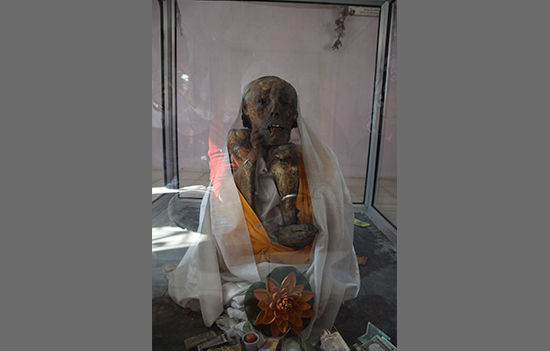 Gue Mummy.
Gue Mummy.
Next
stop with a small detour is Gue, a small village tucked away in a corner
between Sumdo and Tabo. Here one can find a 550-year-old well preserved mummy
of Sangha Tenzing, a Tibetan monk. The mummy is in a sitting position with hair
and teeth intact and is believed to be maintained without any chemicals. Locals
have faith that Sangha Tenzing is still alive and fulfils your wishes. Next to
the mummy is a monastery still under completion. The detour to Gue takes
additional two hours but is definitely worth it.
 Spiti and Sutlej
rivers confluence.
Spiti and Sutlej
rivers confluence.
Next
is an important stop (enroute to Tabo-11,000 feet) at Khab, where one can see
the confluence of Spiti and Sutlej rivers. Across the bridge where the sangam of two rivers can be seen lies
Spiti valley.
Tabo
is a religious and peaceful town i.e. less than an hour away from here. The Monastery next door, sky full of stars and a ten minute
walk was a great close to a busy day!
Day 7: Tabo-Dhankar
 New Monastery, Tabo.
New Monastery, Tabo.
Morning
prayers at Tabo monastery was nothing short of surreal! There is a new
monastery where monks do the prayers while the old monastery dating back to 996
AD and founded by Rinchen Zangpo, a Buddhist scholar and translator on behalf
of the king Yeshe, is delicately preserved and visited under the guidance of a
monk. The walls of the monastery are covered with frescos, paintings, thangkas
and old scriptures. There are nine temples in total with Tsuglakhang being the
most fascinating one. Tabo, located in a flat valley unlike many others which
are typically on a hill, is considered as the oldest operating monastery in
India and Tibet. One can also see the caves on a mountain next to the monastery
where monks meditate.
The
experience of visiting Tabo for a day left me with a thought that one can come
here for a longer stay. Maitreyi Regency is a very decent option to stay.
At
a distance of 35 kms and just under two hours of travel, Dhankar was our next
stop. Staying the night was a great decision. One can start feeling the impact
of height here and a small climb can look difficult for those still not
acclimatized. Essentially, there are three things to do-visiting old monastery,
hiking up to fort in the village and then hiking to the holy Dhankar Lake in
the morning.
 Dhankar Monastery
Dhankar Monastery
The
Dhankar monastery is a 16th century monument though the locals believe that the
Gompa is over 1000 years old. Situated at an elevation of over 12,700 feet, it
is built on a cliff as a fort monastery and overlooks the confluence of Spiti
and Pin rivers amidst the vast expanse of Spiti valley. Belonging to Gelugpa
order of Buddhism, around 150 monks live at the old and the new monasteries.
The
climb to the fort is a small one but definitely worth it, just for the splendid
views of the mountains and the rivers below. It also is a fantastic place for a
photo opportunity!
Day 8: Dhankar-Pin Valley
 Me at Dhankar Lake
Me at Dhankar Lake
An
early morning, six km round trip, hike to Dhankar Lake (13,600 feet) is one of
the highlights in Spiti. A narrow path with a moderate ascend takes you to the
lake in a little over an hour. The splendid views of the snow-capped mountains
in the background and the valley below will remain etched forever in the mind.
As not many people visit this due to low oxygen levels this is a place where
one can sit for hours and enjoy the nature with several shades of colors
reflecting in the lake. The hike down takes just half an hour and is an easy
one.
The
stay options are limited in Dhankar. But one can find a home stay or a small
hotel to spend the night.
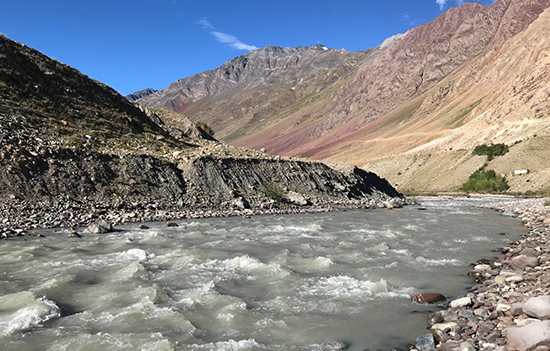 Pin Valley.
Pin Valley.
The drive to Pin Valley national park (12,000 feet) is one of the most scenic in the entire Spiti valley. The changing colors on the mountains – from golden to brown to pink with Pin River flowing at the bottom make the area come alive with abundance of natural beauty.
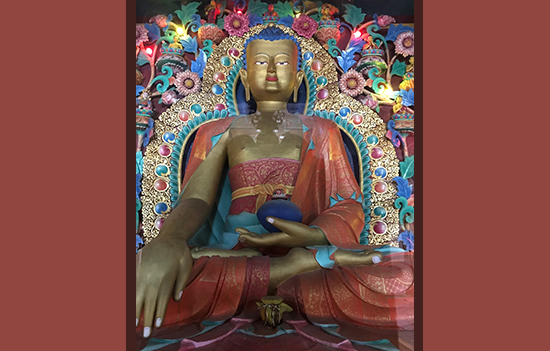 The main Buddha statue at Kungri monastery.
The main Buddha statue at Kungri monastery.
The
Kungri monastery of the Nyingama sect, enroute to Pin Valley, adds to the
charm. Built in the 14th century, this is one of the oldest monasteries in this
area. Driving on an unfriendly non-tar track beyond Mudh, the last village in Pin
Valley adds to the fun.
While
we stayed the night in Pin Valley, it can be skipped and one can move to Kaza, if
short of time. This is a base for Pin Parvati and Pin Bhaba treks.
Day 9: Pin Valley-Kaza
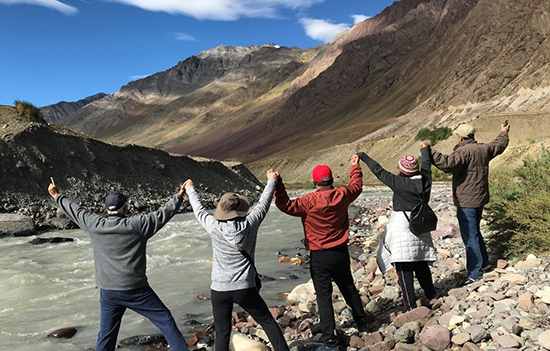 Pin Valley views.
Pin Valley views.
If
one stays at Pin Valley, a walk down to the Pin River in the morning is a must.
Dipping your feet in ice cold glacial waters amidst the sound of the river and
the silence around is fun.
 Inside Deyzor Hotel.
Inside Deyzor Hotel.
A
two hour drive from Pin Valley, Kaza (12,000 feet) is the sub-district
headquarter of Lahaul-Spiti and has all the required facilities. It can be the
base for day trips around. We stayed here for three nights and did half day excursions
leaving sufficient time to just relax here in the evening.
Deyzor,
the 10-room boutique property remains our best stay of this trip. A
pet-friendly hotel with a personalized service from its owner Karanbir Singh
and a lobby full of writings, paintings and memories of people with interesting
artefacts around, it is a cozy place that one can be looking for. The best part
is the exceptional international and local cuisines that the chef dishes out
here that can match anything anywhere in a specialty restaurant. A rider-everything
happens at its own pace though!
Day 10: Kaza-Chicham-Kibber-Kye-Kaza
In
a half day excursion, Chicham gave us the thrill of walking on the 2nd highest
suspension bridge in Asia. The gorge below is 1,000 feet down from the bridge.
Close
by Kibber (14,000 feet) is a little village. With several homestays and basic facilities, this is the place (apart from Pin) where snow leopards and Ibex can be found during the winters. Tourists stay for days here in the hope of a sighting of that elusive snow leopard. This place can be a treat for photographers, wild life lovers and those looking for a feel of a local village.
 Kye Monastery.
Kye Monastery.
On
the way back to Kaza, we crossed the most important and the largest monastery
in the region-the Kye monastery (13,500 feet) where over 300 monks reside.
Perched on a hill and spread over multiple floors, Kye belonging to the Gelugpa
sect (like Tabo and Dhankar) looks quite like the Thiksey in Ladakh. The monastery
provides a beautiful setting and a great view. Spend some time here, visit all the
floors esp. the main prayer hall that has beautiful paintings and murals.
Back
in Kaza, the evening can be well spent with a walk within the city, a visit to
the Kaza monastery, shopping for mementos and snacking at the various options
available in the market. Taste of Spiti, run
by Ecosphere is a good option.
Day 11: Kaza-Langza-Hikkim-Komic-Hikkim-Kaza
This
is another half day excursion that has to be done to enjoy the beauty of this
region. Those short of time can combine the second half day excursions into one
day and cover it along with Kibber.
 Fossils in Langza.
Fossils in Langza.
 Buddha at Langza. Pranams.
Buddha at Langza. Pranams.
Langza
(14,000 feet) is famous for 150-200 million years old fossils of marine animals
and plants that can be found in this region. Part of the ocean several million
years ago, you can find some locals selling these fossils at ridiculously low
prices. Langza has a large Buddha statue that overlooks the stunning valley
below and the barren landscape around. Besides the monastery, Langza also has a
famous ancient lhang where occult practices come alive. We were fortunate to
see the lhang, thanks to our guide.
 Hikkim Post Office is the highest in the world.
Hikkim Post Office is the highest in the world.
Next
stop, Hikkim is famous for having the highest post office in the world.
Suddenly for the first time in our trip, we found ourselves amongst several tourists
trying to write and send post cards to the loved ones. The post office made in
the red color post box shape is clearly an important land mark here. We also
got to see Himalayan Blue sheep here, walking in the wild. Not so lucky with
the Ibex which can be seen later in the winter months.

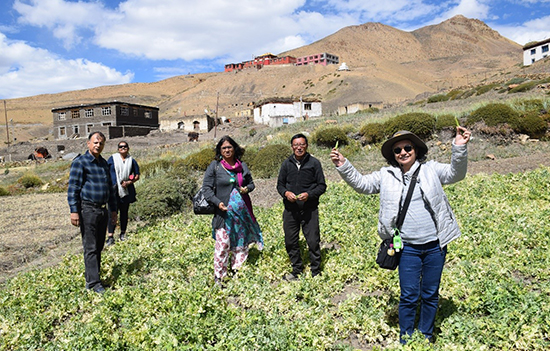 Peas farming at Komic village. Peas delicious.
Peas farming at Komic village. Peas delicious.
A
few kms higher than Hikkim is Komic village which
is reputed to be the highest motorable village in the world. At an
altitude of 15,500 feet, this has Tangyud monastery, one of the highest
altitude monasteries in India. The monastery is one of the few belonging to the
Sakya sect and hence an important place for the people here. We were lucky to
have a delicious meal with a local family here in their home. The village is
less than a kilometer below the monastery and has a few home stay options. We
trekked down two kms from Komic to Hikkim, enjoying the high altitude and the
sharp slopes around. However, it may be advisable to stay in the car for those having
breathing issues.
Day 12: Kaza-Chandrataal
From
Kaza, one crosses over to the other side of the Spiti river that allows you to
get a great view of the Kye monastery. En route, we had a chance to stop at a beautiful
nunnery where young girls stay and study at a monastery. Most of them go to the
lower altitude places, even in south India, in the winter months.
 Kumzum Pass (14,900 feet).
Kumzum Pass (14,900 feet).
Further
up, we did a stopover for lunch at Losar (very scenic) before crossing Kumzum
pass. All drivers and guides pray at the Kumzum temple before proceeding
further. We were to soon realize why they did so as the terrain changes once
again with tarred roads giving way to off-road conditions.
 Drive to Chandratal
Drive to Chandratal
At
100 kms away from Kaza, Chandrataal is the crescent shaped blue water lake that
can be reached by an unpaved and winding road along the Chandra River. It is a
large water body lake considered very holy by locals. The vehicle goes close to
the lake with the last 1.25 km to be covered on foot. The stay options are
basic tents, allowed at a point which is 3 kms before the lake.
 Walking around Chandratal Lake.
Walking around Chandratal Lake.
At
14,000 feet, Chandrataal is probably the most awaited spot in any itinerary in
this region. Serene, splendid, turquoise blue, vast, beautiful, pious, calm-
there are many words that come to mind when you see the lake. Its unparalleled
beauty needs to be seen to believe. The water is crystal clear and one can walk
around the lake to get a feel of its expanse. There are several glaciers around
the lake that continuously feed it. The temperature in this area goes below
zero at night, so one needs to be fully layered.
Day 13: Chandrataal-Manali
 Drive to Manali.
Drive to Manali.
This
was the most difficult terrain we encountered throughout our trip. The road was
non-existent for 80 kms and there were multiple water bodies that had to be
crossed. So, leaving early morning and crossing the streams before they swell
up with melting glaciers is always advisable. While the roads may not be great,
the snow-capped mountains with Chandra River below and shepherds with their
flock of sheep seeking their right to cross, more than make up for all the
challenges in navigating the terrain. A stop at Batal to catch the best aloo parathas
at Chacha Chachi da Dhaba is a must.
 In Spiti language Namaste is called Julley. This is at end of Atal Tunnel.
In Spiti language Namaste is called Julley. This is at end of Atal Tunnel.
The
Lahaul side of the district is once again green and a sign that Manali is not
too far. The road joins the Manali-Leh route before crossing the 10 km long
Atal Tunnel. On the other side of the tunnel, at a few kms away is the famous
Solang Valley.
Day 14: Manali-Naggar-local Manali
Manali is a commercial hill station but a day can be well spent here. Between Manali and Kullu lies Naggar where an old castle is now converted into HPTDC hotel that has some gorgeous views of the valley. Not very far from there is centuries old Krishna temple and Nicholas Roerich Art Gallery, a place frequented by art lovers from around the world. A quick visit to Hadimba temple before spending some time at the mall will conclude a good day’s outing.
 We had the time of our lives, the smiles say it all. Thanks Routed Travels.
We had the time of our lives, the smiles say it all. Thanks Routed Travels.
Day 15: Manali-Chandigarh
All
along the Beas River (starts from a Kund at Rohtang) up to Mandi, the ten hour
drive to Chandigarh can either be done direct or via Rewalsar, a significant
place for Hindus/Buddhists/Sikhs or via Anandpur Sahib, a sacred place for
Sikhs. Navigating Mandi can take time due to road widening and tunnel
construction work going on for a while now. We came direct in time to catch our
flights/train and conclude an extremely memorable trip.
All
pictures by author Neeraj Jain. Copyright of pictures lie with Neeraj.
To see albums
1.
Kalpa
Sangla Valley
2.
Spiti
Valley
3.
Tabo
4.
Solang
Valley Manali
5.
Hadimba
Temple Manali
6.
Chandratal
Lake
7.
Pin
Valley
8.
Drive
from Pune to Spiti Valley